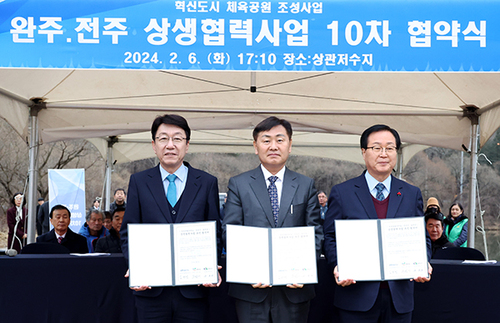| ▲ 전북대학교병원 심장내과 이상록 교수팀이 심장에 위치한 대동맥 판막이 좁아지는 질환을 가슴 절개 없이 대동맥 판막 협착증을 치료하는 '경피적 대동맥 판막 삽입술(Transcatheter Aortic Valve Implantation, TAVI)' 50례를 달성했다. / 사진제공 = 전북대학교병원 © 이요한 기자 |
|
전북대학교병원 심장내과 이상록 교수팀이 가슴 절개 없이 대동맥판막 협착증을 치료하는 '경피적 대동맥 판막 삽입술(Transcatheter Aortic Valve Implantation, TAVI)' 50례를 달성했다.
"대동맥 판막 협착증"은 심장에 위치한 대동맥 판막이 좁아지는 질환으로 발병할 경우, 혈액 흐름 장애 및 심장 과부하로 흉통 및 호흡곤란이 발생하고 심할 경우 실신과 사망에도 이르게 된다.
일단 증상이 발생되면 5년 내 생존율이 20~30% 이하인 매우 위중한 질환으로 과거에는 가슴을 절개하는 수술을 통해 인공판막으로 대체하는 것이 주된 치료법이었다.
전북대병원은 2017년 도내지역 첫 TAVI 시술 성공에 이어 꾸준한 실적을 이어오며 심장내과 우수성을 입증해 환자들이 타 지역 병원을 찾지 않아도 도내에서 편하게 시술을 받을 수 있다는 점에서 각별한 의미를 담고 있다.
특히 경피적 대동맥 판막 삽입술은 치료 중 발생할 수 있는 위험은 물론 수술을 꺼리는 심리적인 부담도 줄일 수 있기 때문에 고령 심장질환자를 적극적으로 치료할 수 있다.
전북대병원 심장내과 이상록 교수는 "많은 퇴행성 대동맥 판막 협착증 환자들이 수술 위험성에 대한 두려움으로 근본적인 치료를 포기하고 증상만 조절해 매우 안타까웠다"며 "'경피적 대동맥 판막 삽입술'은 개흉 수술에 따른 위험은 물론 수술을 꺼리는 심리적 부담을 줄일 수 있어 심장질환으로 고통 받는 고령 환자들의 치료에 새로운 전환점이 될 수 있다"고 밝혔다.
한편 '경피적 대동맥 판막 삽입술'은 심장을 열지 않고 대퇴부(허벅지) 동맥을 따라 스텐트와 유사한 대동맥 판막을 삽입하는 방법이다.
이 삽입술은 고령으로 수술이 불가능하거나 고위험군 환자들에게 사용한다.
전반적인 신체검사를 비롯 심초음파ㆍCTㆍ관상동맥 및 혈관 조영술 등의 예비 검사를 분석해 최종적으로 여부를 결정하게 되며, 시술 시간이 짧고 통증이 적으며 입원 기간 역시 짧다는 이점이 있다.
실제로 개복수술을 할 경우 4~6주간의 회복 기간이 소요되지만 '경피적 대동맥 판막 삽입술'은 5~7일로 회복 기간이 매우 짧은 것이 특징이다.
☞ 아래는 위 기사를 구글 번역이 번역한 영문의 '전문'이다.
【Below is the 'full text' of an English article translated from the above article with Google Translate.】
50 Cases of 'Aortic Valve Insertion' at Chonbuk National University Hospital
Cardiology Professor Sangrok Lee's team… The first 'procedure' success in Tokyo in 2017
Reporter Lee Yohan
Professor Sang-rok Lee's team of cardiology at Chonbuk National University Hospital achieved 50 cases of 'Transcatheter Aortic Valve Implantation (TAVI)', which treats aortic valve stenosis without a chest incision.
"Aortic valve stenosis" is a disease in which the aortic valve located in the heart is narrowed. When it occurs, chest pain and breathing difficulties occur due to blood flow disorders and heart overload, and in severe cases, fainting and death are also caused.
Once symptoms develop, it is a very serious disease with a survival rate of 20 to 30% or less within 5 years. In the past, the main treatment was to replace it with an artificial valve through an incision in the chest.
Chonbuk National University Hospital has a special meaning in that it has proven its excellence in cardiology, following the success of the first TAVI treatment in the province in 2017, so that patients can comfortably receive treatments in the province without visiting other local hospitals.
In particular, since percutaneous aortic valve implantation can reduce the risk that may occur during treatment, as well as the psychological burden of reluctance to operate, it can actively treat elderly heart disease patients.
Professor Sang-rok Lee of the Department of Cardiology at Chonbuk National University Hospital said, "Many patients with degenerative aortic valve stenosis gave up fundamental treatment because of fear of the risk of surgery and controlled only symptoms." It can be a new turning point in the treatment of elderly patients suffering from heart disease by reducing the psychological burden of being reluctant to do so."
Meanwhile, 'percutaneous aortic valve implantation' is a method of inserting a stent-like aortic valve along the femoral (thigh) artery without opening the heart.
This implantation procedure is used for patients in high-risk patients who are unable to perform surgery due to their old age.
The overall physical examination, as well as preliminary examinations such as echocardiography, CT, coronary artery, and angiography, are analyzed to determine the final decision. The treatment time is short, the pain is low, and the hospitalization period is also short.
In fact, open surgery takes 4 to 6 weeks of recovery, but 'percutaneous aortic valve implantation' is characterized by a very short recovery period of 5 to 7 days.





















 많이 본 뉴스
많이 본 뉴스











